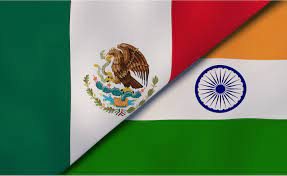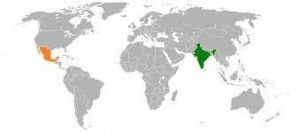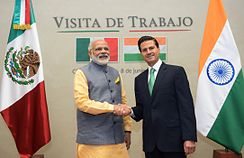The Broadening Realm of India Mexico Partnership presents a gateway of Opportunities

Relations between Mexico and India were established over 75 years ago when in 1947, Mexico became the first Latin American nation to recognise the Independence of India from the United Kingdom. In 1950, both countries established diplomatic relations, and Mexico opened an embassy in Delhi the following year.
The appointment of the first Mexican ambassador to India, former Mexican President Emilio Portes Gil evidences the importance of the new ties between the two nations. And in 1962, Nobel Prize winner Octavio Paz was named ambassador to India.
With the geopolitical scenario changing post-Covid, and at the invitation of India’s External Affairs Minister S Jaishankar, Mexican Foreign Minister Mr Marcelo Ebrard Casaubón’s visited India in March 2022. Subsequent high-level dialogue with his Indian counterpart renewed a boost in the bilateral relations between the nations. Mexico is India’s second-largest trade partner in Latin America and was a member of the UNSC alongside India for the period 2021-22.

The year 2022 has been quite an eventful year for India as the country witnessed an impressive 13.5% growth rate in the second quarter, making it the world’s fastest-growing economy.
Indian economy is doing well in the post-pandemic period and India’s diplomacy is bringing the West much closer steadily despite the occasional points of difference. In the last two decades, China also gained immensely from its China Plus One, also known simply as Plus One or C+1, which is the West’s business strategy to avoid investing only in China and diversifying the business into other countries. However, that scenario is changing fast as China is falling out of favour with the West.
Foreign businesses and investors look at countries with stable governments and growth potential. Analysts are optimistic with a long-term projection of the Indian growth story that seems achievable as the nation is expected to emerge as the world’s fourth-largest economy, overtaking Germany, by 2027. It has begun to live up to its reputation as an attractive destination for foreign investment and a stable player in the global supply chain.
India’s Global Aspirations
India is also in the international limelight as it has taken over the presidency of the G-20 and Shanghai Cooperation Organizations. India also completed a two-year stint on UNSC on December 31, 2022, and remains active in the newly formed QUAD council. But our foreign policy success must meet the momentum in our domestic reforms (political, structural, and economic) agenda. That would help us to achieve our mission of being a prominent player in the global supply chain and capture a significant percentage of global exports.

India’s a trade and commerce ministry has already set an ambitious export target of U.S. $ 2 trillion by 2030. Mr Piyush Goyal, India’s commerce and industry minister, also expects that by 2047, the nation will become a USD 30 trillion economy with a 25 per cent export share. (Source Business Standard)
The Modi-led government is already working on a blueprint for India@2047- a vision plan for a future-ready India that befits the 100th year of Indian Independence. (Source The Economic times, dated January 13 2022)
All these factors would undoubtedly bring changes in the current geopolitical arrangement, where we see a bipolar world revolving around US-China engagement. The emerging world order is likely to be more multipolar, with aspiring global powers like India creating a new space.
Indian foreign policy overreach and Modi Government’s combined politico-strategic concerns with economic advantages and our future international trade objectives would play a decisive role here. Strong bilateral relations and strategic partnerships with nations like Mexico can significantly enhance giant Indian footprints in the American continent.
India-Mexico Relations – Our Historical Ties
Mexico was the first country from Latin America to recognise India after its Independence and establish diplomatic relations with India in 1950. Since then, our relations have always been friendly and warm. Both nations have striking similarities in geography, history, culture, civilisation, and social values. India and Mexico have comparable economic and technological development backgrounds and play essential roles in UNSC as non-permanent members and G 20 block.
Why is Mexico an influential player in Regional Geopolitics?
Mexico is rich in natural resources, like oil, silver, copper, and agricultural products. Mexican economy also boasts a rich diversity of agricultural crops, highly productive oil fields, a solid manufacturing base, and strong trade with the United States and Canada.
Mexico enjoys an excellent relationship with Latin American neighbours. Although technically, it is the third country in North America and foreign policy-wise, Mexicans present themselves as a third-world country with greater affinity to their Latin American neighbours.
But since the 80s, a new elite class educated and trained in the USA joined the country’s political establishment, which slowly transformed Mexico’s relationship with countries both North (Canada and the United States) and central and south America.
The political transformation became evident after Mexico’s government set aside its archaic developmental theories, stopped resisting the North, and decided to become part of it. Today Mexico is a gateway to North & Latin America and enjoys FTAs with 50 countries. (Source Strat News Global)
The region’s close connection between the Mexican and U.S. economies is an essential feature. It reflects a close linkage across the four main economic channels: trade, remittances, investment, and financial.
76% of Mexican exports are destined for sale in the U.S. market, and Mexico is the USA’s third-largest export market and second-largest source of imports. As a result, countries enjoying an excellent diplomatic and economic relationship with Mexico get a platform and opportunity to establish a relationship with the USA.
India – Mexico trade and business relationship: expanding fast and getting stronger.
Both India and Mexico are strong trading and investment partners. Both countries have enjoyed a friendly relationship for over 70 years, and bilateral trade between India and Mexico crossed US$10 bn in 2018. Mexico is the preferred Latin American country for Indian investments and, in turn, the largest investor in India from South America.
More than 220 Indian companies representing the pharmaceutical, information technology, and automotive sectors have invested over US$3 bn-plus U.S. $, employing 60000 Mexicans.

Leading Indian I.T. companies such as TCS, Infosys, Tech Mahindra, Aptech, Hexaware, Wipro, Patni Computer Systems, and Birlasoft have business operations in Mexico. Top pharmaceutical companies such as Lupin, Dr Reddy’s Laboratories, Zydus, Claris Life Sciences, Hetero Drugs, and Sun Pharma have investments and business interests in Mexico. Parle has started a big manufacturing unit in Mexico. OYO Hotel chains also made their entry in 2019 and doing brisk business there.
Indian companies are also in the auto parts, tyres, packaging, and electrical sectors. Large Indian companies such as J.K. Tyre, Bajaj Auto, and SMP group manufacture tyres and auto components and even function as OEMs for global brands Audi and Volkswagen.
Top Mexican companies like Cinépolis, Tremec, Nemak, Softec, Metalsa, and Ruhrpumpen have recently invested in India. NEMAK – a part of the ALFA Group of Mexico, has invested 11 million USD in a manufacturing facility in Chennai. SOFTTEK, from Monterrey, was the first Mexican company to invest in the service sector in India when it invested 26 million USD in acquiring an Indian company in Bangalore. Great Foods & Beverages of Mexico has invested about 10 million USD in India and doing brisk business. ( Source MEA India Reports)
Outlook :
India and Mexico – the geopolitical connection and synergy
India and Mexico are non-permanent United Nations Security Council members during 2021-22. Although both the nations are geographically located miles apart culturally, the two countries share a lot in common. As non-permanent members of the U.N. Security Council and active members of G20, the two countries have a strategic partnership and conduct frequent bilateral dialogue to move forward.
India-Mexico relations are growing and expanding fast on all fronts. Our bilateral trade has surpassed $10 billion, with Mexico emerging as its biggest trading partner of India in Latin America. Large private sector companies of both countries have a stake in the growing relationship.
Businesses have been moving in the right direction. Increased investment flows, growth in tourism, cooperation in science and technology, space, Aerospace, energy, environment, and digital innovation are all indicators of a robust bilateral relationship. It is time for both partners to jointly work on strategies and anchor cooperation around the pacific.

India and Mexico firmly believe in a multipolar world and are willing to work towards using different techniques. As such, the recent visit by Casaubón was a step towards greater cooperation within an emerging multipolar world order becoming a reality.
Russia Ukraine War
The recent voting in the United Nations General Assembly on condemning the Russian invasion of Ukraine on March 2 and on suspending Russia from the U.N. Human Rights Council on April 7 reveal the scale of the thrust toward an independent position taking in the current day global geopolitics.
Of the 58 countries abstaining on April 7, 17 are recognised as influential countries in their respective regions. They are meaningful because of their population size, GDP, possession of nuclear weapons, or cultural impact. The names included are India, Indonesia, Pakistan, and Bangladesh from Asia; Malaysia, Singapore, and Thailand from Southeast Asia; Brazil and Mexico in Latin America; Ghana, Kenya, Nigeria, South Africa, Tanzania, and Uganda from Africa; and Egypt and Jordan from MENA region. India and Mexico have taken a stand against the Russian sanction, although both have strategic alliance partnerships with the U.S.
Suppose we also include China, Iran, Vietnam, and four of the Central Asian countries who voted against on April 7 are added. In that case, 24 countries are capable enough to push back on international issues. This could be a new trend in countries’ independent position on geopolitical issues in the emerging world order. ( Source – U.N. News)
The Way Forward
The economic relationship between India and Mexico is in expanding mode. One way to sustain this new-found momentum in bilateral ties is to explore avenues for further business collaboration. Mexico, one of Latin America’s major economies, is one of the focus countries for Indian business. However, the real potential of the India-Mexico bilateral commercial and economic relationship is yet to be realised.
During his last visit to Mexico in 2016, India’s Prime minister Mr Narendra Modi and Mexican president, Mr Peña Nieto, held an elaborate discussion on the subject. Both the leaders agreed to cooperate in promoting reciprocal business investments and expand the current ventures in various sectors such as the steel, pharmaceutical, food and auto parts industries” and even the expansion of Mexican companies in Indian movie theatres.

The leaders also resolved to create a roadmap where high-level officials meet on trade, investment, and cooperation at periodical intervals. The new focus would be enhancing digital strategy programmes, renewable energy, Aerospace, and energy security.
They realised the essence of going beyond the normal buyer-seller relationship and forming a long-term strategic alliance to work on a shared vision. As the two countries seek to bolster their “strategic partnership further”, it is natural that India and Mexico would begin to examine sectors that provide avenues for greater collaboration. ( Source – Gobierno de Mexico)
Verdict
South America is a rapidly developing economy and presents ample market opportunities to emerging powers. The continent is not only industrially prosperous but offers a sizeable import-export market. South America comprises about 382 million people living in twelve nations, contributing to 6% of the world’s population. Countries like Brazil and Mexico are the region’s economic powerhouses and play a significant role in regional geopolitics.
PwC UK, a leading global think tank and advisor, has already listed the top 10 likely economic powerhouses in the new international economic order by 2050. The countries listed by PwC include (in descending order) China, India, the USA, Indonesia, Brazil, Russia, Mexico, Japan, Germany and the U.K. A key takeaway would be that global economic powers will shift to the E7 economies, and G7 economies will be trailing behind. ( Source PwC UK)
The policymakers of the respective countries got to handle a few challenges, like adopting green technologies in nation-building, avoiding protectionism at all costs, and ensuring that the potential benefits of globalisation are shared more equally across society.
Indian policymakers are already on the job and working on a blueprint for India@2047- a vision plan for a ‘future ready India’ that befits the 100th year of Indian Independence. Prime Minister’s Office and the cabinet secretary assigned the 10 Sectoral Group of Secretaries (SGoS) to draw up a road map for the plan, and rounds of meetings have been held across ministries on the same. ( Source Economic Times).
As we advance, India Mexico Strategic partnership is expected to intensify with high-level dialogues, business visits and investments facilitating more Indian footprints in Latin American countries.
An Excellent report…full of insights and pragmatic thoughts and solutions.
Brilliant!
Thanks Rehan
Utpal
Deep and Rational report
Thanks.
Encouraging Compliment
Regards
Utpal
Verу descriptive post, I loved that a lot. Wiⅼl there be a part 2?
Thanks.
Not Immediately. Next post, I am planning on Australia
Good and excellent write up India vs Mexico relationship. You are a deepen knowledgeable as well as good analyst.
Thanks for sharing it to me.
Thanks, Sunil Ji
Regards
Utpal